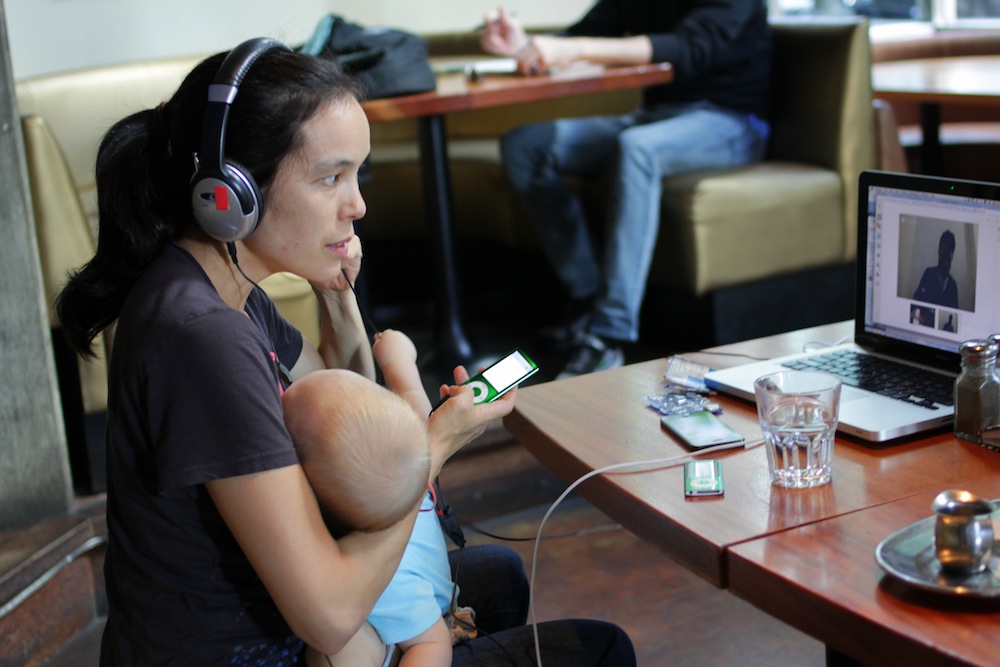
I figured out I was pregnant with our second kid in April 2014. Estimated due date: December 2, 2014. The countdown was on.
After the initial elation subsided, an unexpected depression set in. One night, amid the funk, my partner Nathan said, “you can still be an artist.”
Like the best collaborators, he had put words to the crisis I couldn’t name. I was so tired already, so stretched by my roles as parent, partner, artist. Getting work done was just starting to get a teensy bit easier. Our first child was 18-months and becoming more independent week by week. Our family seemed to have struck a balance between work hours and childcare; art-making and child-rearing. We were sleeping. The prospect of re-entering the chaos of the early infant stages was daunting.
Things are just starting to cook for me in my artistic practice. Am I sabotaging myself, interrupting my flow, disrupting a promising career arc? I need to find new constellations to help navigate these next few years. I wish for pre-baby clarity of mind, but bumble forward with what feels like short-term brain damage brought on by too many Cheerios and too little sleep.
Before having kids I had the privilege of watching some exceptional artists balance parenthood and art-making. Many in Vancouver’s indie theatre scene have kids. In the early days of Neworld (before I came on board) the Leaky Heaven Circus started as a creation project for artists and their kids (and dogs – but that’s a different story).
As an emerging artist working with numerous companies, I observed differences between those run by childless artists versus those run by parents. Everyone worked hard, but in the companies with parents, the work conditions felt more generous. Often it meant that folks were more upfront about their scheduling needs and boundaries. Sometimes that meant that hours of work were adjusted to accommodate the families; sometimes that meant that children were present onsite or even in the rehearsal room.

The family-friendly working model put more pressure on the unattached or childless company members. I’ve been that person, too. For many, many years I was the ‘SINK’ in the office – single income no kids. I worked with folks who had children ranging from twos to tweens to teens. Meetings ended at 2:45pm so kids could be picked up from school. Meetings were postponed because kids got sick. Or sick kids coughed and wheezed in the next room while points were quickly ticked off the agenda. Inevitably, if tasks fell after hours or on the weekends, they fell to me.
And now it’s me asking my colleagues and collaborators to plan meetings based on naptimes and child care. And I’m the one showing up tired and distracted.
My training and practice in theatre help me parent. Everyday I use the secrets of the trade. How is it possible to read the same book over and over and over again? Acting training… and maybe having dabbled in durational theatre. Gotta get a baby in or out of your back-pack carrier? Call on the principles of contact improv you learned in movement class!
Working in theatre taught me how to communicate, to have difficult conversations and to collaborate – skills I use with my partner as we figure out what parenting means for us. Theatre also taught me to improvise, to empathize, to employ modes of communication beyond language, to be present in the moment – all of these have helped me to decode my child’s needs and wants. Being at home with a small child can sometimes be mind-numbingly boring. On those interminable afternoons, I’m grateful for the hours I’ve spent in a rehearsal room or in tech waiting. Just… waiting…
My hope is that being a parent is helping to make me into a better theatre-maker. I keep a notebook of ideas for shows and installations. There’s no way I’ll ever be able to produce all these projects, but the ideas keep coming. These past two years have been deeply creative. Never had so many ideas! But never so little capacity to execute them.
I have zero desire to perform for strangers right now. I spend all day performing various, elaborate scenes for an audience of one. I ponder and research and design experiences for my son with the same care and precision that I do my other work. In some ways it is easier to create performances for him, because the answer to the creator’s question, “What do you want the audience to come away with?” is very clear. I want the audience to have a full stomach, or a clean diaper, or a sense of accomplishment, or to be asleep. (For 12 hours, no intermission.)
With each day crammed full of activities and tasks that I move between without pause, my artistic process has necessarily slowed down. The projects I’m working on now I started at least a year before my first was born. But I like living with the ideas for longer.
This all seems possible because of the privileges I have. I am not freelancing or dependent on gigs to pay rent. And I work with an amazing group of colleagues and collaborators who support the variety of needs we all have while participating in a creation process.
Moreover, these colleagues and I have control over our means of production: we are the means of production. We have the ability to adjust timelines and meetings to accommodate due dates, parental leaves, illnesses and naps. These are the gifts that we can give each other when we recognize, collectively, that we don’t need to adhere to standard models of scheduling or rehearsal – models that have more to do with industrial production than the creation of art.
And the works of art that have really affected me reflect and relate to lived experience, they draw attention to the messiness of life. Nothing has made me feel more alive than being a parent, with all its wildness and unpredictability and body fluids. Right now, this is it: this is the place from which I work. Surrounded by used tissues and plastic dinosaurs, by half-read books and interrupted thoughts, and the unbearable sweetness of peanut butter smooches drying on my cheek.










